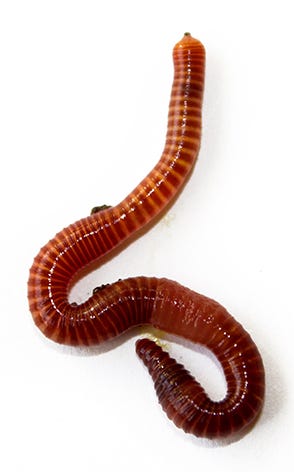Eco-conscious red worms: Ways to maximize results
Red Wigglers: Your Eco-Friendly Service for a Greener Garden
Red wigglers, or Eisenia fetida, offer a sustainable strategy to improving yard wellness with vermicomposting. These worms not only facilitate the failure of organic waste yet also add to improved dirt structure and fertility. By integrating red wigglers into your gardening practices, you can efficiently manage waste while supporting a vivid ecological community (red worms). The benefits extend past plain composting; recognizing the nuances of their care and optimal usage can dramatically elevate your gardening initiatives. What important methods can ensure your vermicomposting system flourishes while optimizing its effect on your garden's vitality?
(Hickory)
What Are Red Wigglers?
Although often incorrect for routine earthworms, red wigglers (Eisenia fetida) are a distinct varieties recognized for their effectiveness in composting organic matter. These worms prosper in rich, organic atmospheres, such as garden compost piles and vermicomposting systems, where they play a critical duty in breaking down waste. Unlike their even more typical counterparts, red wigglers prefer a warmer habitat, commonly between 55 ° F and 77 ° F, which optimizes their activity and productivity.
Red wigglers are identified by their reddish-brown coloration and fractional bodies, which can mature to four inches in size. They possess a special capacity to take in and absorb natural materials at an impressive rate, refining as much as half their body weight daily. This rapid decomposition process not only enriches the dirt however additionally adds to the general health of the yard ecosystem.
In regards to recreation, red wigglers are prolific, with the ability of creating cocoons which contain numerous eggs. This allows for fast populace development, making them an excellent selection for composting undertakings. Their adaptability and ravenous appetite for organic waste position red wigglers as an essential ally for eco conscious garden enthusiasts looking for sustainable practices.
Advantages of Making Use Of Red Wigglers
Using red wigglers in the yard offers countless advantages that improve both dirt quality and plant health and wellness. These earthworms are exceptional decomposers, damaging down raw material such as kitchen area scraps and lawn waste right into nutrient-rich castings. These spreadings, usually described as "worm gold," supply necessary nutrients that improve dirt fertility, promoting dynamic plant growth.
Red wigglers additionally improve dirt framework. Their burrowing task aerates the dirt, promoting much better water seepage and origin infiltration. This causes a much healthier origin system, which is critical for nutrient uptake and overall plant vigor. Moreover, the presence of red wigglers boosts red wigglers for composting microbial activity in the soil, creating a thriving ecosystem that adds to illness resistance and boosted plant health.
Another considerable benefit of utilizing red wigglers is their capability to decrease waste. In summary, incorporating red wigglers right into gardening methods returns substantial advantages, making them an important enhancement to any type of eco-conscious yard.
(Worm Farms Near Me)
How to Begin Vermicomposting
To begin vermicomposting, it's necessary to develop an appropriate atmosphere for red wigglers to thrive, as their success directly impacts the performance of the composting process. Begin by choosing a container, such as a plastic or wood container, with sufficient drain and air flow. A dimension of about 2 square feet is excellent for a house, enabling a manageable worm population.
Next, prepare bedding material that is wet but not overly wet. Shredded newspaper, cardboard, and coconut coir are exceptional selections, supplying a comfortable environment while likewise acting as a carbon source. Load the container with 4 to 6 inches of bed linen.
After establishing the bed linens, introduce your red wigglers. A regular beginning population has to do with 1 extra pound of worms, which can eat approximately half an extra pound of food scraps daily. It is essential to include food scraps progressively, concentrating on veggie peelings, fruit waste, and coffee grounds, while avoiding meat, dairy, and oily foods to prevent smells.
Keeping a Healthy And Balanced Worm Bin
As soon as your red wigglers are worked out right into their brand-new bed linen, keeping a healthy and balanced worm container comes to be critical to ensure ideal composting conditions. Ideally, the worm bin need to be kept wet but not soaked; a humidity degree around 60-70% is optimal.
Temperature control is similarly important. Red wigglers prosper in atmospheres in between 55 ° F and 77 ° F(13 ° C to 25 ° C) Avoid exposing the container to extreme temperatures; severe warmth can eliminate the worms, while too much cold can slow their activity.
Oygenation is essential to avoid anaerobic problems, which can cause unpleasant smells and hurt the worms. Turn the bed linens carefully every couple of weeks to advertise air flow and distribute food equally.
Feeding your red wigglers is an additional essential element. Offer a balanced diet of cooking area scraps, preventing citrus and spicy foods, which can be damaging to their health. By regularly checking these factors, you can guarantee a growing ecosystem within your worm bin.

Tips for Making Use Of Worm Castings
Consistently integrating worm castings right into your yard can substantially enhance dirt health and plant development. To successfully utilize worm spreadings, start by identifying the proper application price, which typically varies from 10-20% of the total soil volume. This makes sure ideal nutrient schedule without frustrating your plants.
When applying worm spreadings, mix them right into the top couple of inches of soil around recognized plants or integrate them right into your seed-starting mix for new seed startings. In addition, consider producing a worm tea by soaking worm spreadings in water for 24-48 hours.

Verdict
The use of red wigglers in gardening methods provides a sustainable technique to waste management and soil enrichment. The integration of red wigglers right into horticulture regimens inevitably sustains both eco-friendly equilibrium and farming performance. red worms.